| Forty Scenes of the Yuanmingyuan | |
|---|---|
 | |
| Year | 1744 |
| Location | France |
| [edit on Wikidata] | |
The painting series Forty Scenes of the Yuanmingyuan depicts historically recognized vistas in the Old Summer Palace in Beijing, China. In 1744, the Qianlong Emperor commissioned a set of forty paintings from two court artists, Shen Yuan and Tangdai, and a calligrapher, Wang Youdun. The paintings, currently in the collection of Bibliothèque nationale de France, are among the few remaining visual records of the Yuanmingyuan prior to the sack by French and British troops in 1860. Twenty-four out of the forty garden scenes depicted in paintings were lost in the destruction of 1860, the remaining scenes have been lost over time since then.
Gallery
-
 Hall of Rectitude and Honor
Hall of Rectitude and Honor
Chinese: 正大光明; pinyin: Zhèngdà guāngmíng -
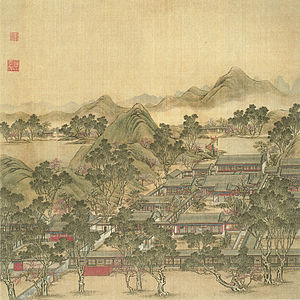 Diligent and Talented Government
Diligent and Talented Government
Chinese: 勤政親賢; pinyin: Qínzhèng qīnxián -
 Nine Continents Clear and Calm (Emperor’s Private Residence)
Nine Continents Clear and Calm (Emperor’s Private Residence)
Chinese: 九州清宴; pinyin: Jiǔzhōu qīngyàn -
 Engraved Moon and Unfolding Clouds
Engraved Moon and Unfolding Clouds
Chinese: 牡丹臺; pinyin: Mǔdān tái
Chinese: 鏤月開雲; pinyin: Louyue kaiyun -
 A Painting of Nature
A Painting of Nature
Chinese: 天然圖畫; pinyin: Tiānrán túhuà -
 Green Wutong Tree Academy
Green Wutong Tree Academy
Chinese: 碧桐書院; pinyin: Bìtóng shūyuàn -
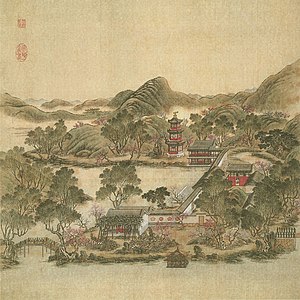 Merciful Clouds Protect All (Island of Shrines)
Merciful Clouds Protect All (Island of Shrines)
Chinese: 慈雲普護; pinyin: Cíyún pǔhù -
 Heavenly Light Above and Below
Heavenly Light Above and Below
Chinese: 上下天光; pinyin: Shàngxià tiānguāng -
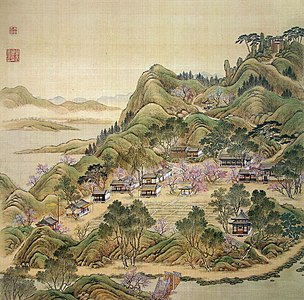 Apricot Blossom Spring Villa
Apricot Blossom Spring Villa
Chinese: 杏花春館; pinyin: Xìnghuā chūnguǎn -
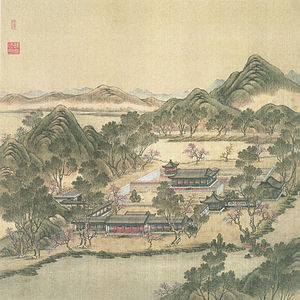 The Magnanimous World
The Magnanimous World
Chinese: 坦坦蕩蕩; pinyin: Tǎntǎn dàngdàng -
 Harmony of the Present with the Past
Harmony of the Present with the Past
Chinese: 茹古涵今; pinyin: Rúgǔ hánjīn -
 Eternal Spring Immortals Hall
Eternal Spring Immortals Hall
Chinese: 長春仙館; pinyin: Chángchūn xianguǎn -
 Peace and Harmony Everywhere (Swastika House)
Peace and Harmony Everywhere (Swastika House)
Chinese: 萬方安和; pinyin: Wànfāng ānhé -
 Spring Color at Wuling
Spring Color at Wuling
Chinese: 武陵春色; pinyin: Wǔlíng chūnsè -
 Hills High and Waters Long (The Drill Field)
Hills High and Waters Long (The Drill Field)
Chinese: 山高水長; pinyin: Shāngāo shuǐcháng -
 Dwelling of the Moon, Earth, and Clouds
Dwelling of the Moon, Earth, and Clouds
Chinese: 月地雲居; pinyin: Yuèdi yúnjū -
 Vast Compassion and Eternal Blessing (Ancestral Shrine)
Vast Compassion and Eternal Blessing (Ancestral Shrine)
Chinese: 鴻慈永祜; pinyin: Hóngcí yǒnghù -
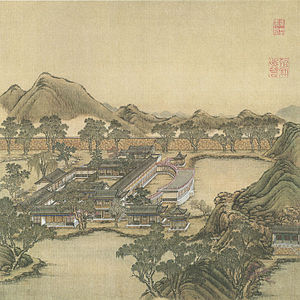 Library of Collected Fragrances
Library of Collected Fragrances
Chinese: 彙芳書院; pinyin: Huìfāng shūyuàn -
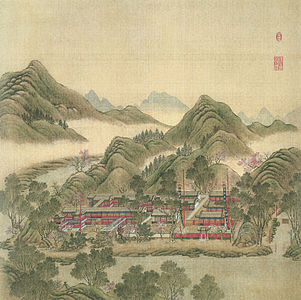 Dazzling Eaves Under Heaven (Buddhist compound)
Dazzling Eaves Under Heaven (Buddhist compound)
Chinese: 日天琳宇; pinyin: Rìtiān línyǔ -
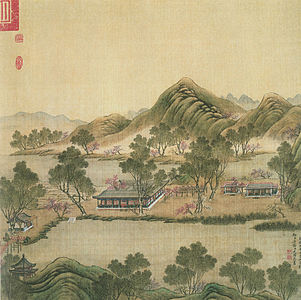 Simple Life in Quietude (The “Field” Character Building)
Simple Life in Quietude (The “Field” Character Building)
Chinese: 澹泊寧靜; pinyin: Dànbó níngjìng -
 Reflections on Water and Fragrance of Iris
Reflections on Water and Fragrance of Iris
Chinese: 映水蘭香; pinyin: Yìngshuǐ lánxiāng -
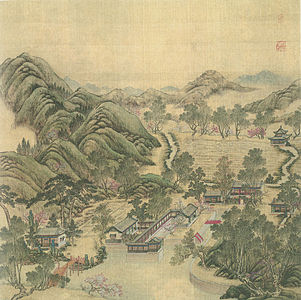 Sounds of Trees and Water
Sounds of Trees and Water
Chinese: 水木明瑟; pinyin: Shuǐmù míngsè -
 Happy Place of Lianxi
Happy Place of Lianxi
Chinese: 濂溪樂處; pinyin: Liánxī lèchù -
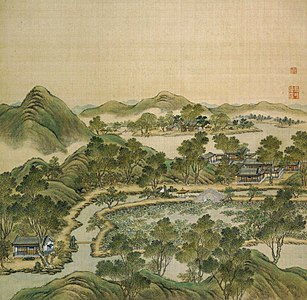 Crops as Beautiful as the Clouds
Crops as Beautiful as the Clouds
Chinese: 多稼如雲; pinyin: Duōjia rúyún -
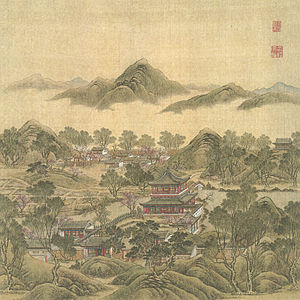 Fish Leap and Birds Fly
Fish Leap and Birds Fly
Chinese: 魚躍鳶飛; pinyin: Yúyuè yuānfēi -
 Village of Distant Northern Mountains
Village of Distant Northern Mountains
Chinese: 北遠山村; pinyin: Běi yuǎn shān cūn -
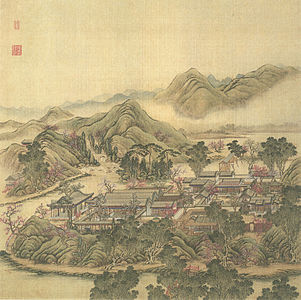 Elegant Color of the Western Peaks
Elegant Color of the Western Peaks
Chinese: 西峰秀色; pinyin: Xifēng xiùsè -
 Library of the Four Seasons
Library of the Four Seasons
Chinese: 四宜書屋; pinyin: Sìyi shūwū -
 Beautiful Scene of the Square Pot
Beautiful Scene of the Square Pot
Chinese: 方壺勝景; pinyin: Fānghú shèngjǐng -
 Bath in Virtue
Bath in Virtue
Chinese: 澡身浴德; pinyin: Zǎoshēn yùdé -
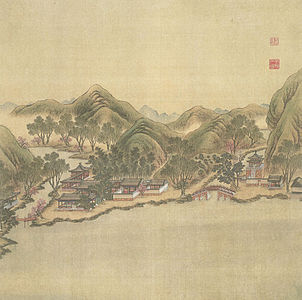 Calm Lake Under the Autumn Moon
Calm Lake Under the Autumn Moon
Chinese: 平湖秋月; pinyin: Pínghú qiūyuè -
 Jade Terrace of Paradise Island
Jade Terrace of Paradise Island
Chinese: 蓬島瑤臺; pinyin: Péngdǎo yáotái -
 House Which Meets the Beauty of the Hills
House Which Meets the Beauty of the Hills
Chinese: 接秀山房; pinyin: Jiēxiù shānfáng -
 There Is Another Cave Of Heaven
There Is Another Cave Of Heaven
Chinese: 別有洞天; pinyin: Bié yǒu dòngtiān -
 Double Reflection and Sound of the Lute
Double Reflection and Sound of the Lute
Chinese: 夾鏡鳴琴; pinyin: Jiājìng míngqín -
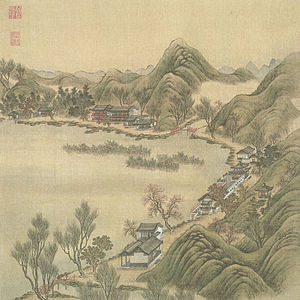 Vast Empty Clear Mirror
Vast Empty Clear Mirror
Chinese: 涵虛朗鑒; pinyin: Hánxū lǎngjiàn -
 Boundless Impartiality
Boundless Impartiality
Chinese: 廓然大公; pinyin: Kuòrán dàgōng -
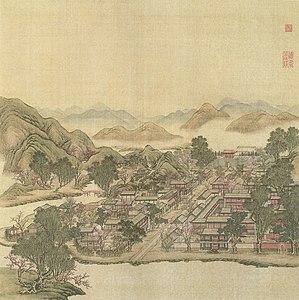 Sitting Rocks and Winding Stream
Sitting Rocks and Winding Stream
Chinese: 坐石臨流; pinyin: Zuòshí línliú -
 Distillery and Lotus Pond
Distillery and Lotus Pond
Chinese: 麴院風荷; pinyin: Qūyuàn fēnghé -
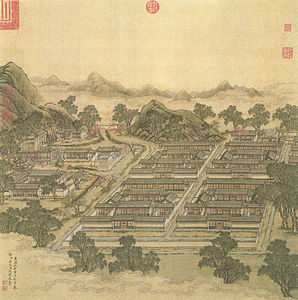 Deep Vault of Heaven (The Princes’ School)
Deep Vault of Heaven (The Princes’ School)
Chinese: 洞天深處; pinyin: Dòngtiān shēnchù
References
Footnotes
- ^ Li, Lillian. "The Garden of Perfect Brightness – 1: The Yuanmingyuan as Imperial Paradise (1700-1860)". MIT Visualizing Cultures. Massachusetts Institute of Technology. Retrieved 9 March 2013.
- Wang Daocheng (2005) in "Should Yuanmingyuan Be Rebuilt?", People's Daily Online
Sources
- For 40 scenes in reduced size reproduction, and Chinese language comments about the original park activities, see Yuan Ming Cang Sang 圓明滄桑 (in Simplified Chinese). Beijing: Wenhua Yishu Chubanshe (文化兿術出版社). 1991. ISBN 7-5039-1010-0.